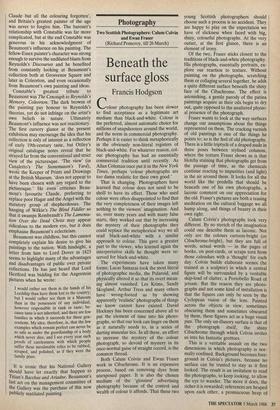ARTS
Exhibitions
Solid objects of concern
Alistair Hicks
`Noble and Patriotic': The Beaumont Gift 1828 (National Gallery, till 3 May) Sir George Beaumont believed he could improve British taste with a National Gal- lery. Works of art, he thought, would then become 'not merely toys for connoisseurs but solid objects of concern to the nation'. His wife was more realistic and prophetic, maintaining that 'the public was not to be bullied into patronage of the arts'. It was she who bought the most important paint- Detail from Claude's 'Landscape with Hagar and the Angel' ing in Beaumont's bequest to the nation of 16 paintings, Rubens's Chateau de Steen landscape. The current exhibition of these works at the National Gallery may not have a dramatic instant appeal, but does raise many questions about changing taste, the role of the 'connoisseur' come patron/ critic and indeed the function of the Gallery itself.
Beaumont has received much of the credit for the belated foundation of the National Gallery in 1824, yet even Felicity Owen, an indirect descendant, cannot paint a conclusive portrait in her recent book (Collector of Genius: A Life of Sir George Beaumont, by Felicity Owen and David Blayney Brown, Yale University Press). Chatty family reminiscences are successfully caught by a web of cross- references to other leading lights at this crucial stage in the still only elementarily charted history of collecting. Only the occasional punch is pulled as the man who bribed Lord Liverpool with the words 'Buy Angerstein's collection and I will give you mine' is revealed as both fickle and vision- ary, bigoted and progressive. Benjamin Robert Haydon evokes both sides of Beaumont's character in fulsome terms. 'Sir George never comes to Town,' he wrote, tut he brings Doubt, Irresolu- tion & Misery in his train, to let loose upon every Artist, as his whim directs and his fancy excites.' A few days later he added that the baronet was 'the clog of English art — as one who hates Modern art, as one who would rather have blood wrung from him than money.' Yet after a visit to Coleorton, the Beaumonts' northern home, he was inspired to write that 'they had dined with Claude and Rembrandt before us, breakfasted with the Rubens landscape, and did nothing, morning, noon or night, but think of painting, dream of painting and wake to paint again.' Beaumont's patronage of Wilkie, Haydon and Jackson is contrasted with his hostility to Turner and ambiguity to his friend Constable. By 1809 Turner was refusing to sell a painting to Beaumont. Sir George may have been the leading amateur painter of the day, the high priest of taste and close friend and supporter of Wordsworth and Coleridge, but he had earlier dismissed Turner's The Opening of the Vintage at Macon as 'borrowed from Claude but all the colouring forgotten', and Britain's greatest painter of the age was never to forgive him. The baronet's relationship with Constable was far more complicated, but at the end Constable was generous in his acknowledgment of Beaumont's influence on his painting. The fellow-Essex painter's character was strong enough to survive the undiluted blasts from Reynolds's Discourses and he benefited from constantly looking at Beaumont's collection both at Grosvenor Square and later in Coleorton, and even occasionally from Beaumont's own painting and ideas.
Constable's greatest tribute to Beaumont was The Cenotaph to Reynolds's Memory, Coleorton. The dark browns of the painting pay honour to Reynolds's theories, yet do not infringe on the artist's own beliefs in nature. Ultimately Beaumont's influence was not reactionary. The first cursory glance at the present exhibition may encourage the idea that his collection is only of interest as a reflection of early 19th-century taste, but Ottley's original catalogue notes reveal that he strayed far from the conventional and strict view of the picturesque. 'The view' (in Canaletto's The Stonemason's Yard), wrote the Keeper of Prints and Drawings at the British Museum. 'does not appear to have been chosen with any regard to the picturesque.' He even criticises Beau- mont's favourite Claude, preferring to replace poor Hagar and the Angel with the statutory group of shepherdesses. The hanging of Wilkie's The Blind Fiddler so that it swamps Rembrandt's The Lamenta- tion Over the Dead Christ may appear ridiculous to the modern eye, but it does emphasise Beaumont's eclecticism. Beaumont was childless, but this cannot completely explain his desire to give his paintings to the nation. With hindsight, a letter from him to Lord Dover in 1823 seems to highlight many of the advantages and disadvantages of public over private collections. He has just heard that Lord Hertford was bidding for the Angerstein pictures when he wrote: I would rather see them in the hands of his Lordship than have them lost to the country; but I would rather see them in a Museum than in the possession of any individual, however responsible in rank or taste; be- cause taste is not inherited, and there are few families in which it succeeds for three gen- erations. My idea, therefore, is, that the few examples which remain perfect can never be so safe as under the guardianship of a body which never dies; and I see every year such proofs of carelessness with which people suffer these inestimable relics to be rubbed, scraped, and polished, as if they were the family plate.
It is ironic that his National Gallery should have let exactly that happen to Titian's Bacchus and Ariadne. Beaumont's last act on the management committee of the Gallery was the purchase of this now publicly mutilated painting.



















































 Previous page
Previous page